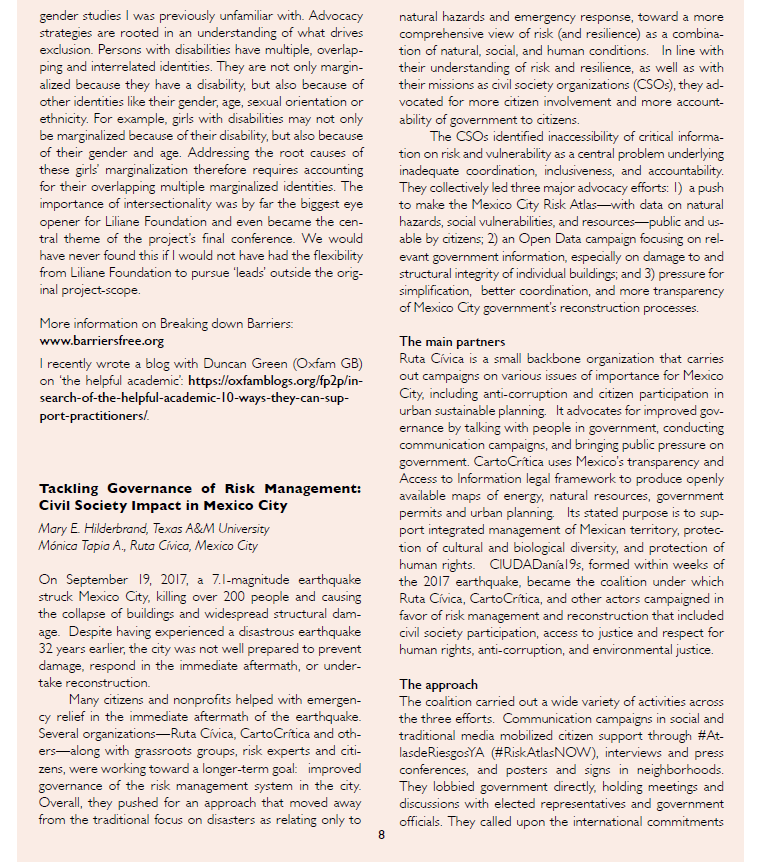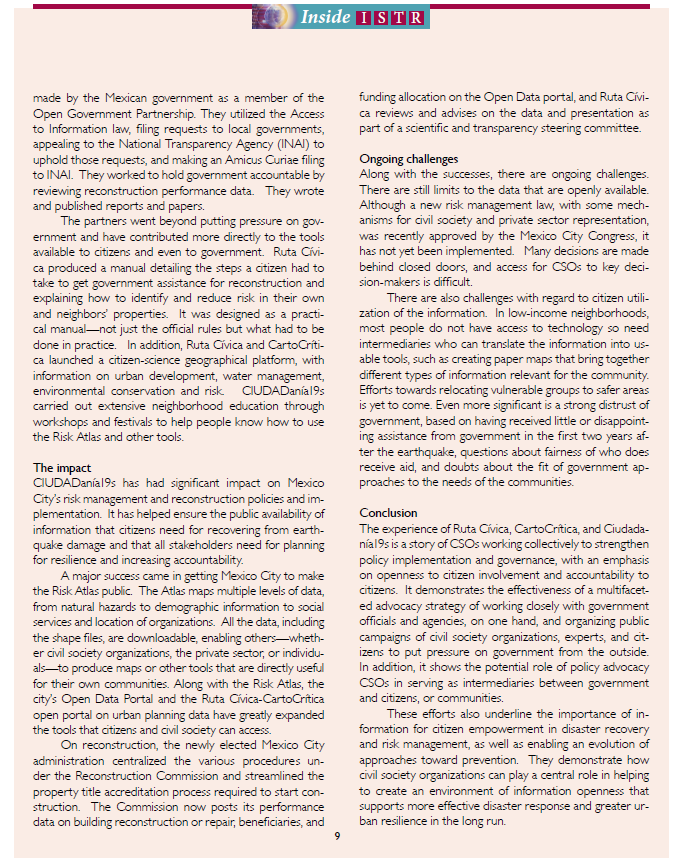- La Sociedad Internacional para la Investigación sobre el Tercer Sector (ISTR, por sus siglas den inglés) hizo una reconocimiento especial como parte del Premio de Investigación del Impacto de Sociedad Civil 2020.
- Junto con otras experiencias en Uruguay, Estados Unidos, México y Reino Unido, el impacto de Ruta Cívica fue publicado en el boletin trimestral de la Sociedad Internacional.
- La investigación es parte de una colaboración con la Universidad Texas A&M con Ruta Cívica desde 2017.
A continuación el articulo publicado (en INGLÉS):
Tackling Governance of Risk Management: Civil Society Impact in Mexico City
Mary E. Hilderbrand, Texas A&M University y Mónica Tapia A., Ruta Cívica, Mexico City
On September 19, 2017, a 7.1-magnitude earthquake struck Mexico City, killing over 200 people and causing the collapse of buildings and widespread structural damage. Despite having experienced a disastrous earthquake 32 years earlier, the city was not well prepared to prevent damage, respond in the immediate aftermath, or undertake reconstruction.
Many citizens and nonprofits helped with emergency relief in the immediate aftermath of the earthquake. Several organizations—Ruta Cívica, CartoCrítica and others—along with grassroots groups, risk experts and citizens, were working toward a longer-term goal: improved governance of the risk management system in the city. Overall, they pushed for an approach that moved away from the traditional focus on disasters as relating only to natural hazards and emergency response, toward a more comprehensive view of risk (and resilience) as a combination of natural, social, and human conditions. In line with their understanding of risk and resilience, as well as with their missions as civil society organizations (CSOs), they advocated for more citizen involvement and more accountability of government to citizens.
The CSOs identified inaccessibility of critical information on risk and vulnerability as a central problem underlying inadequate coordination, inclusiveness, and accountability. They collectively led three major advocacy efforts: 1) a push to make the Mexico City Risk Atlas—with data on natural hazards, social vulnerabilities, and resources—public and usable by citizens; 2) an Open Data campaign focusing on relevant government information, especially on damage to and structural integrity of individual buildings; and 3) pressure for simplification, better coordination, and more transparency of Mexico City government’s reconstruction processes.
The main partners
Ruta Cívica is a small backbone organization that carries out campaigns on various issues of importance for Mexico City, including anti-corruption and citizen participation in urban sustainable planning. It advocates for improved governance by talking with people in government, conducting communication campaigns, and bringing public pressure on government. CartoCrítica uses Mexico’s transparency and Access to Information legal framework to produce openly available maps of energy, natural resources, government permits and urban planning. Its stated purpose is to support integrated management of Mexican territory, protection of cultural and biological diversity, and protection of human rights. CIUDADanía19s, formed within weeks of the 2017 earthquake, became the coalition under which Ruta Cívica, CartoCrítica, and other actors campaigned in favor of risk management and reconstruction that included civil society participation, access to justice and respect for human rights, anti-corruption, and environmental justice.
The approach
The coalition carried out a wide variety of activities across the three efforts. Communication campaigns in social and traditional media mobilized citizen support through #AtlasdeRiesgosYA (#RiskAtlasNOW), interviews and press conferences, and posters and signs in neighborhoods. They lobbied government directly, holding meetings and discussions with elected representatives and government officials. They called upon the international commitments made by the Mexican government as a member of the Open Government Partnership. They utilized the Access to Information law, filing requests to local governments, appealing to the National Transparency Agency (INAI) to uphold those requests, and making an Amicus Curiae filing to INAI. They worked to hold government accountable by reviewing reconstruction performance data. They wrote and published reports and papers.
The partners went beyond putting pressure on government and have contributed more directly to the tools available to citizens and even to government. Ruta Cívica produced a manual detailing the steps a citizen had to take to get government assistance for reconstruction and explaining how to identify and reduce risk in their own and neighbors’ properties. It was designed as a practical manual—not just the official rules but what had to be done in practice. In addition, Ruta Cívica and CartoCrítica launched a citizen-science geographical platform, with information on urban development, water management, environmental conservation and risk. CIUDADanía19s carried out extensive neighborhood education through workshops and festivals to help people know how to use the Risk Atlas and other tools.
The impact
CIUDADanía19s has had significant impact on Mexico City’s risk management and reconstruction policies and implementation. It has helped ensure the public availability of information that citizens need for recovering from earthquake damage and that all stakeholders need for planning for resilience and increasing accountability.
A major success came in getting Mexico City to make the Risk Atlas public. The Atlas maps multiple levels of data, from natural hazards to demographic information to social services and location of organizations. All the data, including the shape files, are downloadable, enabling others—whether civil society organizations, the private sector, or individuals—to produce maps or other tools that are directly useful for their own communities. Along with the Risk Atlas, the city’s Open Data Portal and the Ruta Cívica-CartoCrítica open portal on urban planning data have greatly expanded the tools that citizens and civil society can access.
On reconstruction, the newly elected Mexico City administration centralized the various procedures under the Reconstruction Commission and streamlined the property title accreditation process required to start construction. The Commission now posts its performance data on building reconstruction or repair, beneficiaries, and funding allocation on the Open Data portal, and Ruta Cívica reviews and advises on the data and presentation as part of a scientific and transparency steering committee.
Ongoing challenges
Along with the successes, there are ongoing challenges. There are still limits to the data that are openly available. Although a new risk management law, with some mechanisms for civil society and private sector representation, was recently approved by the Mexico City Congress, it has not yet been implemented. Many decisions are made behind closed doors, and access for CSOs to key decision-makers is difficult.
There are also challenges with regard to citizen utilization of the information. In low-income neighborhoods, most people do not have access to technology so need intermediaries who can translate the information into usable tools, such as creating paper maps that bring together different types of information relevant for the community. Efforts towards relocating vulnerable groups to safer areas is yet to come. Even more significant is a strong distrust of government, based on having received little or disappointing assistance from government in the first two years after the earthquake, questions about fairness of who does receive aid, and doubts about the fit of government approaches to the needs of the communities.
Conclusion
The experience of Ruta Cívica, CartoCrítica, and Ciudadanía19s is a story of CSOs working collectively to strengthen policy implementation and governance, with an emphasis on openness to citizen involvement and accountability to citizens. It demonstrates the effectiveness of a multifaceted advocacy strategy of working closely with government officials and agencies, on one hand, and organizing public campaigns of civil society organizations, experts, and citizens to put pressure on government from the outside. In addition, it shows the potential role of policy advocacy CSOs in serving as intermediaries between government and citizens, or communities.
These efforts also underline the importance of information for citizen empowerment in disaster recovery and risk management, as well as enabling an evolution of approaches toward prevention. They demonstrate how civil society organizations can play a central role in helping to create an environment of information openness that supports more effective disaster response and greater urban resilience in the long run.
Aquí se puede consultar el articulo completo, aquí la página web del ISTR y aquí la página de la Universidad Texas A&M



